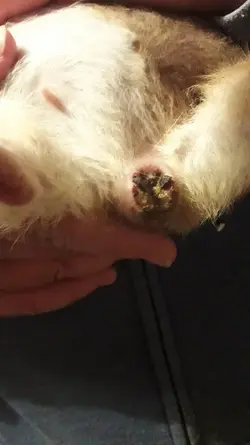LilyThePiggy
Junior Guinea Pig
Hi, I was wondering if anyone could help me figure out what might be happening or maybe what to do next.
I took my guinea pig to the vet about 6 weeks ago because she was screaming when she peed which turned out to be stones. She got an operation to get them out but at the same time we noticed she had lost a lot of weight and her back end was soaking wet with some sort of brown liquid which wasn't her pee and her poo seemed normal. We were confused to what it might be but assumed that it would be related to her peeing problem and it would get better when she recovered from her operation.
It hasn't. Despite it being weeks since the operation with her now eating really well she is still skin and bones possible even skinnier than before the operation.
Just over a week ago her stomach got really bloated over just a few days (she looks heavily pregnant) but she's still skins and bones. Her bum had also gotten worse, it wasnt as wet but there was a little bit of some sort of brown sludge type stuff coming out. There was also hard brown circles which I think where scabs that she had caused herself.
I took her to the vet and they gave her an ultrasound but couldn't see much all they could see was fluid and didn't know what was wrong. We were given some antibiotics and were told that the next step might be an Xray to see if they can find anything.
Over the past few days the stomach issue and weight hasn't changed but there is more brown stuff coming out her bum and it seems to be sore now, so we took her back to the vet. It was a different vet who tried to give an ultrasound again but still couldn't find anything, she couldn't see through the fluid. She told us to stop the antibiotics because they weren't doing anything and gave us pain killers instead.
We were told that our options were to give her an Xray to investigate further, to let her continue the way she is with her pain killers or to put her to sleep.
She still feels really lively and pretty happy guinea pig so I'm reluctant to put her down. I just sort of lost for what I can do next so i was looking for any kind of advice really.
Thanks
I took my guinea pig to the vet about 6 weeks ago because she was screaming when she peed which turned out to be stones. She got an operation to get them out but at the same time we noticed she had lost a lot of weight and her back end was soaking wet with some sort of brown liquid which wasn't her pee and her poo seemed normal. We were confused to what it might be but assumed that it would be related to her peeing problem and it would get better when she recovered from her operation.
It hasn't. Despite it being weeks since the operation with her now eating really well she is still skin and bones possible even skinnier than before the operation.
Just over a week ago her stomach got really bloated over just a few days (she looks heavily pregnant) but she's still skins and bones. Her bum had also gotten worse, it wasnt as wet but there was a little bit of some sort of brown sludge type stuff coming out. There was also hard brown circles which I think where scabs that she had caused herself.
I took her to the vet and they gave her an ultrasound but couldn't see much all they could see was fluid and didn't know what was wrong. We were given some antibiotics and were told that the next step might be an Xray to see if they can find anything.
Over the past few days the stomach issue and weight hasn't changed but there is more brown stuff coming out her bum and it seems to be sore now, so we took her back to the vet. It was a different vet who tried to give an ultrasound again but still couldn't find anything, she couldn't see through the fluid. She told us to stop the antibiotics because they weren't doing anything and gave us pain killers instead.
We were told that our options were to give her an Xray to investigate further, to let her continue the way she is with her pain killers or to put her to sleep.
She still feels really lively and pretty happy guinea pig so I'm reluctant to put her down. I just sort of lost for what I can do next so i was looking for any kind of advice really.
Thanks
